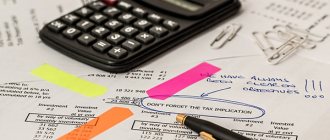Hello to all my readers! Today I’m answering a question from several readers, but I’m not doing it in the Q&A section, but in the general feed, because I want everyone to know about this once and for all and not ask such a question! I looked at the queries in search engines and saw that there were queries, but no answers! More precisely, there are answers about what kind of markup to make, but there are incomprehensible numbers taken from the ceiling and it is not clear where the author took them from. I’m used to explaining everything, so I’ll answer the question with a full but short article. So, let's begin!
Markup and margin - what is the difference and how to calculate them
In professional conversations among entrepreneurs, you can often hear the terms “markup” and “margin,” and many do not see the difference between them. Let's figure it out.
The goal of business is to make a profit, and the markup should guarantee this
Margin is the amount of added value to the selling price of a product. It is calculated as the difference between the purchase price and the retail price. In fact, the margin shows how much “dirty” profit the company will receive if it sells the product. For example, a store bought a sausage roll for 150 rubles and sold it for 200 rubles. Thus, the margin was 50 rubles.
As a percentage, the margin is calculated using the formula:
Margin= (sales price - purchase price)/sales price * 100%
In our example: Margin = (200 - 150)/200 * 100% = 25%.
Trade margin is an addition to the purchase price. Let's look at how to determine the markup on a product in quantitative form.
Trade margin = selling price - purchase price
If we take our example, the trade margin in it will be 50 rubles. Thus, in quantitative terms, it is always equal to the margin. The situation is somewhat different if you calculate the trade margin as a percentage. The following formula is used for this:
Trade margin = (sales price - purchase price)/purchase price * 100%
In our example: Trade margin = (200 - 150)/150 * 100% = 33%.
In fact, the difference between the trading margin and the margin is insignificant and appears only in percentage terms. Which term is more appropriate to use in work and in communication is up to the entrepreneur to decide. Next, we will look at how to determine the markup and what factors you need to pay attention to.
Mathematical calculation of markup
After all the analyzes carried out, you can set a certain markup. There are two methods here.
The first one is the simplest. You simply add the desired profit to the costs and get the value. This method is as simple as possible, but it has disadvantages. First, it does not take into account changes in the market. And secondly, it does not show to what extent you can reduce the price if, for example, you are having a sale. You will not be able to accurately determine the amount of profit. It will always be less than expected, since there is almost always some part of unsold goods left, and if you have seasonal products, at the end of the season you will have to sell off the remainder at discounts. Plus, various troubles and losses can happen, from which no one is immune.
The second way is to determine the markup using the break-even method. This method allows you to set minimum production volumes at which the company will operate without losses. The markup percentage here is calculated using the formula: 1-(volume of planned gross revenue / Variable costs) * 100%. Let's say you expect gross revenue of 30 million. Costs – 10 million. 1-(30 / 10)*100% = 200%. This is the minimum markup for the product. Based on the market situation and the characteristics of the product, you increase this coefficient to the one you need. This method will provide you with 100% profit.
Factors determining the size of the markup
A properly calculated trade margin should not only cover costs, but also provide the owner with a good profit. The manager's goal is to set prices for goods that will ensure the maximum total margin in the long term.
The cost of products should also take into account the solvency of the target audience; price tags should not scare off regular customers.
Price war exhausts competitors, but allows buyers to save money
Some entrepreneurs are embarrassed to make a large trade markup, and as a result they only lose profit. But there is also no need to go too far with a high price, otherwise many customers will go to competitors. As a result, entrepreneurs, when determining the level of markup, need to look for the “golden mean”, and for this they need to become familiar with the factors that influence pricing:
- minimum price;
- market situation;
- competitor analysis;
- elasticity of demand;
- offering additional services;
- buyer's solvency.
To analyze the effectiveness of pricing policy, it is reasonable to use the ECAM warehouse accounting program. This trade automation application is capable of providing an entrepreneur with profit data for an arbitrary period of time by product groups.
With an inventory accounting program, you can assign a separate markup to each product category, and then analyze the impact of the established margin level on sales and net income. As a result, you can quickly determine the values of optimal markups by product groups, which will provide the business with maximum profit.
Formula for calculating trade margins
To avoid errors in calculations, a special formula is used to calculate the markup as a percentage. When assigning a trade margin (TM) nominally, it is not difficult to determine it in monetary terms:
TN = ST * % TN , here CT is the cost of the product, % TN is the percentage of the assigned trade margin.
An important and significant area of running a successful business is the financial analysis of the company’s trading activities. This is done by financial and economic specialists and private entrepreneurs themselves.
Sales analysis helps to calculate the trade markup actually established after sales:
ТН = (РВ - СТ) ÷ СТ , where РВ is the real proceeds from the sale, СТ is the cost of the goods.
A serious economic indicator for determining a trade markup is the gross income received as a result of the sale of goods. Calculate gross income based on the specifics of accounting for turnover.
- Based on general trade turnover with an established single percentage of trade markup. This method is rational if the goods sold have homogeneous characteristics. Gross income (IG) is calculated using a fairly simple formula: VD = T * RTH ÷ 100, where T is the total turnover, which is equal to the amount of revenue taking into account all taxes, RTN is the calculated trade margin, which is determined as follows: RTN = TN ÷ (100 + TN), and TN is the trade margin, expressed as a percentage.
- According to the range of trade turnover. This method is suitable where trade turnover is kept track of different groups. Each group is united by goods with homogeneous characteristics and an individual trade markup. Gross income is also found by groups, and then summed up: (T1 * RTN1 + T2 * RTN2 + ... + Tn * RTNn) ÷ 100 , where T1, T2, Tn are turnover by product groups RTN1, RTN2, RTNn are estimated trade margins for groups accordingly.
- Based on the average percentage established for the trade margin. Small companies use this method because of its ease of calculation. However, the desired result will be averaged, which is inappropriate to show in official reporting. Gross income is found as follows: VD = T * SrTN ÷ 100 , where T is the total turnover, SrTN is the average trade margin on goods sold, which is calculated according to the formula: SrTN = (TNN + TNP - TNV) ÷ (T+OK) * 100 , where TNN, TNP, TNV are trade margins for the reporting period, respectively at: the beginning of the period, goods received, disposed of due to return to the supplier or written off; OK – balance at the end of the reporting period.
- According to the range of remaining goods. Compared to the previous method, this one gives a more accurate result, but is labor-intensive. It is appropriate to use special software for small businesses that keep records using barcodes. To use this method of calculation, a prerequisite is to conduct a monthly inventory. Here, gross income will be calculated according to a simple principle: VD = TNN + TNP – TNV – TNK , where TNN, TNP, TNV, TNK are trade margins for the reporting period at: beginning, arrivals, departures and at the end of the reporting period.
Threshold price: we insure against working at a loss
The threshold price is the minimum cost of the product, which guarantees the break-even of the business. This indicator is calculated in several stages.
First, before determining the standard trading margin, an entrepreneur must calculate all his fixed and variable expenses: rent, salaries, utilities, taxes, etc. Let’s say they are equal to 80 thousand rubles per month.
Any discount must guarantee a profit
At the second stage, the actual or planned volume of sales of goods is determined, and their total purchase cost is determined. Let's say it is equal to 120 thousand rubles.
At the third stage, the formula calculates the average level of trade margin, which will cover current costs:
Trade margin = (monthly expenses)/(total purchase price of goods sold per month) * 100% = 80 thousand rubles/120 thousand rubles *100% = 66%
At the fourth and final stage, the minimum (threshold) price is calculated, which will ensure break-even trading.
Minimum price = purchase price + (purchase price*trade margin)
Thus, we obtain the minimum price at which the product can be sold, taking into account all discounts. It must be remembered that the established markup should always ensure that the cost of the product is not less than the threshold.
Trade margins, their purpose. The procedure for controlling trade margins
Content
Introduction……………………………………………………………………………….5
1. Trade margins, their purpose. The procedure for controlling trade margins.
2. Accounting for trade margins.
2.1. Synthetic accounting of trade margins in trade.
2.2. Analytical accounting of trade margins.
3. The procedure for calculating the implementation of trade margins in trade margin organizations.
4. Analysis of enterprise income for the year.
4.1. Analysis of enterprise income for the reporting period.
4.2. Analysis of other income.
5. Calculation of the influence of factors on the amount and level of gross income at the enterprise.
6. Conclusion.
7. List of references.
8. Application.
Introduction
Trade is currently perhaps one of the most attractive activities. First of all, this attractiveness lies in the fairly rapid turnover of funds and making a profit.
What is trade? According to the State Standard of the Russian Federation GOST R 51303-99 “Trade. Terms and definitions “trade is “a type of business activity associated with the purchase and sale of goods and the provision of services to customers.” Retail trade plays a significant role in the modern world.
The relevance of the chosen topic lies in the important growth in the development of retail trade, since it is retail trade that allows not only to dynamically respond to changes in the market environment, but also to improve the quality of life by timely satisfying the needs of each consumer. That is, competition among wholesale operators is increasing; for example, in a number of cities we can talk about the physical saturation of the market with large stores and shopping centers. New forms of retail are emerging. Retail trade does not stand still and changes along with changes in human society. Volatile consumer behavior is the biggest driver of change in retail. The object of the study is Bryanskregionopt LLC. Purpose of the work: to analyze the activities of Bryanskregionopt LLC. To achieve this goal, it is necessary to solve the following tasks:
— purpose, procedure for monitoring trade margins
— synthetic and analytical accounting of trade margins in trade
— the procedure for calculating the sale of trade margins in the organization
— analysis of income at the enterprise, calculation of the influence of factors on the amount and level of gross income at the enterprise.
According to the charter, the organizational form of Bryanskregionopt LLC is considered to be a book and journal form of accounting, as well as an automated form - a computer program. In this case, all accounting registers are printed and stored on paper.
The basis for entries in accounting registers are accounting documents recording the completion of a business transaction. Primary documents must contain the following mandatory details: name of the document (form), form code, date of preparation, content of the business transaction, measures of the business transaction, name of the organization, signatures of the persons responsible for the transaction. Depending on the nature of the transaction, the requirements of regulations and the technology for processing accounting information, additional details may be included in the primary documents. Analytical accounting is carried out in parallel with synthetic accounting.
Timely and reliable creation of primary documents and deadlines for reflection in accounting is carried out in accordance with the document flow procedure approved by the organization. Unspecified corrections are not permitted in primary documents and accounting registers.
Primary documents, accounting registers, financial statements are subject to mandatory storage in accordance with the established procedure and deadlines.
The accounting department maintains accounting records of property and business transactions by double entry in the accounting books; accounting provides:
— completeness of reflections in accounting for the reporting period (month, quarter, year) of all business transactions carried out during this period and the results of property inventories;
— the correctness of attributing income and expenses to reporting periods (income and expenses are reflected in the period to which they relate).
Primary documents, registers, financial statements are subject to storage in the archive in accordance with the established procedure and deadlines
Limited Liability Company "Bryanskregionopt", hereinafter referred to as the "Company", is created and operates in accordance with the Civil Code of the Russian Federation and the Federal Law of the Russian Federation "On Limited Liability Companies" No. 14-FZ dated 02/08/98, the Law "On Consumer cooperation (consumer societies, their unions) in the Russian Federation" No. 3085-1 dated June 19, 1992. and other current legislation.
Location of the company: Bryansk region, Bryansk, Moskovsky Ave., 7
The Company is a legal entity and conducts its activities on the basis of this charter and the current legislation of the Russian Federation. The period of activity of the Company is not limited.
The only member of the Company is the Bryansk Regional Union of Consumer Societies (Bryansk Regional Consumer Societies), 2410505, Bryansk, Kalinina St., 99-A.
The Company is a commercial organization.
The goals of the Company's activities are to expand the market for goods and services and generate profit.
Bryanskregionopt LLC carries out the following activities:
-wholesale trade of alcoholic and other drinks
-wholesale trade of food products, including drinks, and tobacco products
— wholesale trade in non-food consumer goods
-other ratailing
-retail trade in non-specialized stores
-activities of nursing staff
-renting out your own non-residential real estate
-providing intermediary services in the purchase, sale, rental of non-residential real estate
-providing various types of services.
Table 1 - General characteristics of the enterprise
| Indicators | year 2009 | 2010 | Dynamics, %, deviation (+,-) |
| Revenue, thousand rubles Cost, thousand rubles. Gross profit, thousand rubles. Profit from sales, thousand rubles. Other income, thousand rubles. Other expenses, thousand rubles. Net profit, thousand rubles. Average number of employees, people. Average salary, thousand rubles. | 206552 170135 36417 1617 1268 1046 316 85 13466 | 190750 158780 31970 1402 1382 551 869 79 10865 | 92.3 93.3 87.8 86.7 109 52.7 275 — 6 — 2601 |
Having analyzed the data of Bryanskregionpt LLC, we can come to the conclusion that the company’s revenue decreased by 7.7%, which negatively characterizes the work of the enterprise, but other expenses significantly decreased by 47.3%, which is positive, the number of employees also decreased by 6 employees, but wages workers' wages did not increase, but decreased by 2,601 rubles, which is negative. A noticeable increase in net profit by 175% can be considered positive.
Trade margins, their purpose. The procedure for controlling trade margins
Trade margin is the difference between the selling price and the purchase price of a product. The minimum size of the trade margin must cover the costs of selling the goods - this is the case if the sale of the goods does not bring profit, but at least does not bring loss. There are such situations. Reducing the trading margin below this minimum leads to trading at a loss and aims to at least reduce this loss to a minimum. As a rule, an organization resorts to this measure in cases where selling a product at a markup, including the costs of its sale and profit, becomes impossible. In this case, of course, it is better to sell the product at a loss (or without profit) than not to sell it at all. The size of the markup is determined by the organization independently. Moreover, the markup can be set either uniformly for the entire range of goods, or different according to the types of product groups. The retail company should consolidate the option used in its accounting policies
So, the retail price (as well as the wholesale price when resale of goods through an intermediary - a wholesaler) consists of the delivery price set by the supplier and the trade margin. The price calculation formula in this case will look like this:
Product price = Purchase price + Trade margin + VAT on the sales price (including if the organization is on the general taxation system). (1)
Since currently in retail trade the seller is subject to a single tax on imputed income, the formula simplifies to:
Purchase cost + Trade margin. (2)
In accordance with clause 13 of PBU 5/01 “Accounting for inventories”, as well as clause 60 of the Regulations on accounting and financial reporting, approved by order of the Ministry of Finance of Russia dated July 29, 1998 N 34n, goods purchased by an organization for sale, are valued at their acquisition cost. An organization engaged in retail trade is allowed to evaluate purchased goods at their selling price with separate consideration of markups (discounts).
Thus, only those organizations that engage in retail trade have the right to record goods at sales value. Keeping records of goods at sales value is a right, not an obligation, so the choice made must be formalized in the accounting policy for accounting purposes.
To summarize information about the availability and movement of goods, account 41 “Goods” is intended in accordance with the Chart of Accounts for accounting financial and economic activities of organizations and the Instructions for its application, approved by Order of the Ministry of Finance of Russia dated October 31, 2000 N 94n. In order for an organization engaged in retail trade to account for goods not at the purchase price, but at the selling price, account 42 “Trade margin” is used in accounting. Account 42 reflects information about trade margins (discounts, markups).
Like any other operation, the markup of goods is reflected in accounting based on the primary document. There is no unified form of primary documents to reflect the markup, therefore, on the basis of Art. 9 of the Federal Law of November 21, 1996 N 129-FZ “On Accounting”, a retail trading company can develop its own form and consolidate its use in accounting policies.
The method for calculating trade margins is not fixed by law, therefore a trading enterprise has the right to use any methodology approved by the organization, namely:
— first set the selling price, and then calculate the trade margin (used when monitoring retail prices for other organizations);
— establish a trade margin for a specific product (group of products) in the form of a fixed amount (used, for example, when the organization is a dealer of the product manufacturer);
— set a trade margin for a specific product (group of products) in the form of a fixed percentage.
The posting of goods arriving at the warehouse is reflected in the debit of account 41 “Goods” in correspondence with account 60 “Settlements with suppliers and contractors” at the cost of their acquisition. When accounting for goods at sales prices, simultaneously with this entry, an entry is made to the debit of account 41 “Goods” and the credit of account 42 “Trade margin” for the difference between the acquisition cost and the cost at sales prices (discounts, markups).
In this case, in the debit of account 41 “Goods”, the goods will be reflected at the selling price. From the credit of account 41 “Goods” to the debit 90 “Sales”, the cost of all goods sold at the selling price will be written off in one amount equal to the amount of revenue received for these goods.
Simultaneously with writing off the sales value of goods on the credit of account 42 “Trade margin”, the amount of the trade margin relating to these sales is reversed to the debit of account 90 “Sales”.
The amount of the trade margin, which relates to goods sold, is determined by calculation. The calculation is documented using an accounting certificate.
The calculation of the realized trade overlay (margin) is carried out in this order.
1. First, calculate the percentage of trade margin for the month (P):
P = (Hk+Np) : (T + Ok), (3)
Where:
Hk - the amount of markup on the balance of goods at the beginning of the month - account balance 42 at the beginning of the month;
Np - the amount of markup on goods received during the month - turnover on the credit of account 42;
T - turnover (the amount of goods sold per month) in sales prices - turnover on the credit of account 90, subaccount “Revenue”;
Ok - balance of goods at the end of the billing month in sales prices - debit balance of account 41.
2. Next, the amount of the markup on the balance of goods (Nk) is calculated as the product of the balance of goods at the end of the month in sales prices (Ok) by the calculated percentage of the trade markup (P):
Hk = Ok x P (4)
3. The amount of the realized margin (Нр) is determined by summing the trade margin at the beginning of the month (Нн) and the received trade margin (Нп) minus the trade margin at the end of the month (Нк):
Нр = Нк + Нп — Нк (5)
Market situation and competitor analysis
When setting a markup, you should also take into account the pricing policies of competitors. You should find out the cost of all similar products presented by your opponent. But what price should you set for yourself in the end?
You need to study prices from competitors anonymously, trying to find out all the details of their pricing policy
Under equal trading conditions, it is better not to dump and indicate the cost of goods as a competitor. Especially if there is a high probability that the rival will also reduce the price, because as a result a trade war will break out, which will bring losses to both entrepreneurs.
It is better to win customer loyalty in other ways: service, goodwill, promotions, etc. This way you can attract buyers and make a good profit due to high markups.
The ECAM warehouse accounting program will help you create your own discount card system. It is available even to entrepreneurs with small incomes who are engaged in retail trade and the provision of ]Warehouse accounting program[/anchor] allows you to maintain a customer base, analyze sales and plan purchases, so its purchase will pay for itself in a matter of months.
Accounting for trade margins
Let's consider accounting for trade margins in retail trade. Postings with examples of amounts from the “Calculation Formula” section:
| Operation | Sum | D | TO |
| Goods accepted for accounting | 23 935 | 41 | 60 |
| TN | 12 585 | 41 | 42 |
| The cost of selling goods is written off | 21 135 | 90 | 41 |
| The sold HP was written off | 15 513,09 | 90 | 42 |
| Profit | 15 513,09 | 90 | 99 |
Elasticity of demand
In the absence of competitors and stable demand, you can set a fairly high markup. For example, if there is only one company in the city that specializes in refilling printer cartridges, then it can set the cost of services within a fairly wide range. But you need to know the limit.
Determining trade margins with elastic demand is more difficult
After all, with widespread customer dissatisfaction with high prices, the company will quickly have competitors who will want to satisfy the demand for a cheaper service. And dissatisfied customers, and in fact they will be the majority, will move to their rivals.
If the product offered is a minor one, for example, luxury jewelry, cigars, massage services, then as the price increases, revenue will fall. In this case, demand is elastic and it is important to find the maximum trading margin that will suit the majority of representatives of the target audience. Otherwise, sales will begin to plummet.
Offering additional services
Most people are willing to overpay when purchasing for additional services, comfort, extended warranty and other bonuses. Therefore, with a well-delivered service, entrepreneurs can safely make a higher markup than their competitors.
The presence of a guarantee is an important criterion when choosing a store
An example is elite shoe repair, which provides a visit to the client, the use of imported consumables, compensation for damaged shoes, a long-term quality guarantee, etc. The markup in such a workshop can be several times higher than that of an ordinary “shoemaker”.
Additional services in retail trade may include deferment, sale of goods on credit, free delivery or installation. But the cost of these bonuses must be taken into account when creating markups on goods. After all, the purpose of providing additional services is to increase profits, and not just to gain customer loyalty.
Buyer's solvency
Analysis of the needs and capabilities of the target audience is very important when determining the trade margin. It allows you not to miss out on profits by selling the most popular products.
In the elite segment of goods, the price is limited only by the size of the buyer’s wallet
For example, let’s compare the pricing policy in the food zone of a large shopping center and in a small cafe located in the private sector. In the shopping center, wealthy customers are willing to pay both 100 and 200 rubles for a hamburger. Moreover, both prices will suit them quite well. So why charge less if you can earn more?
In a cafe located in the private sector, visitors will already think about whether to buy a hamburger for 200 hryvnia or whether it is better to go home and buy several times more food for that money.
Finding the extreme price at which the target audience is still ready to buy most often has to be done empirically. First, it is worth setting average market prices for everything, and then gradually increasing the markup for one product group until demand drops. Based on the last “running” price, it is necessary to determine the average trade margin for all other products.
What markup can be made on goods according to the law?
As we noted above, for most products, services and product groups in Russia there are no restrictions on the size of the trade markup. It is determined by business entities themselves, taking into account the realities of the market situation. But there are specific socially significant product groups for which the state sets maximum trade markups. These include:
- medical products;
- pharmaceuticals;
- baby food;
- dishes and products of public catering facilities located in educational institutions;
- products that are delivered to the regions of the Far North and equivalent areas.
Allowances for medical products and pharmaceuticals, as well as their list, are regulated by the Russian Government. For other services and products, premiums are set by regional authorities.
It should also be borne in mind that a markup of more than 30% is not allowed on essential food products. These are bakery products, groceries, meat, dairy products and other goods, the prices of which form the cost of the consumer basket.
How much money should I charge for the service?
Pricing in the service industry is quite complex.
By providing a unique service, you can earn much more
Therefore, when calculating the cost of their work, entrepreneurs must be guided by a number of criteria:
- Time spent. Whatever service is provided, the entrepreneur must earn at least 2000-3000 rubles per day.
- Established market prices. For example, it is unlikely that a client will come to a service station to change the oil if the cost of the service is 20-30% higher than that of a competitor.
- Market positioning. Setting a markup higher than the market average is possible in a company that provides high quality work, short deadlines for completion, or additional guarantees. But your advantages will have to be constantly confirmed by practice.
- Client portrait. It is no secret that many entrepreneurs, knowing about the client’s wealth, can significantly inflate the cost of the services provided without any reason.
Thus, the pricing of services largely depends on the market situation and the ingenuity of the entrepreneur.
Accounting for various markups within one store
Quite often, stores use several markup values at once, depending on whether the product belongs to a certain product category. This is especially true for grocery markets and hardware stores. In this case, it is difficult for the manager to take into account various markups, so they are often averaged, resulting in loss of profit.
The ECAM warehouse accounting program allows you to control your business remotely
The ECAM warehouse accounting program can correct the situation. This application allows you to automatically set prices for goods based on a specified markup. Moreover, its level can be set for each product category. As a result, the manager does not think every day about how to determine the markup on the product, which saves him from routine work.
In addition, the warehouse accounting program gives the entrepreneur a powerful analytical system that allows him to track the impact of the markup level on demand within each assortment group. This helps create optimal margins to maximize store profits.
Average markups
Each industry has its own markups on goods that have been established over the years:
- Clothing items – 40%-105%
- Jewelry and souvenirs – 100%-250%
- Auto parts and accessories for cars – 30%-55%
- Household utensils, household supplies – 25%-65%
- Cosmetics – 25%-75%
You can rely on these indicators when calculating your markup. But you don’t need to stay strictly within the limits. It is best to rely on competent market analysis and your own calculations.








